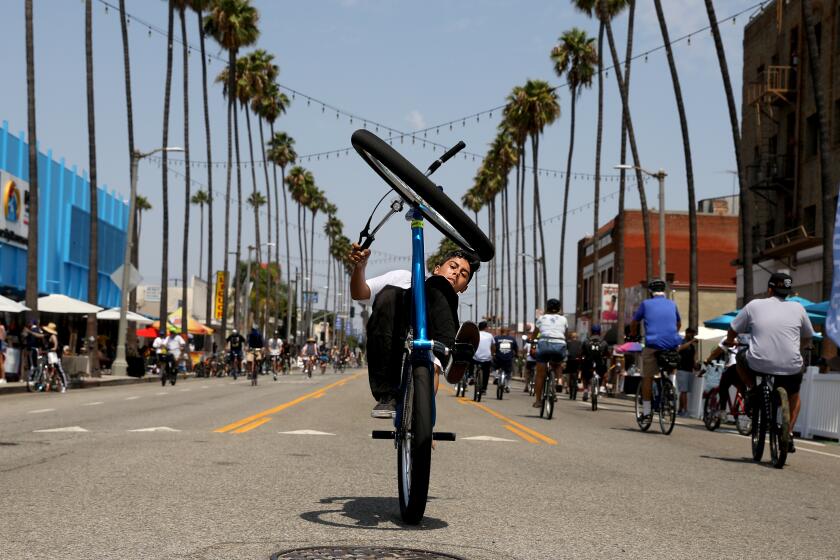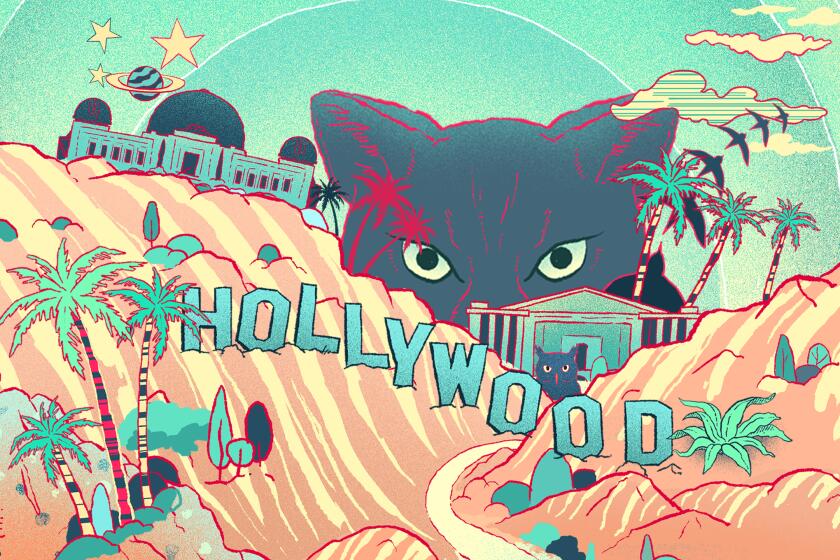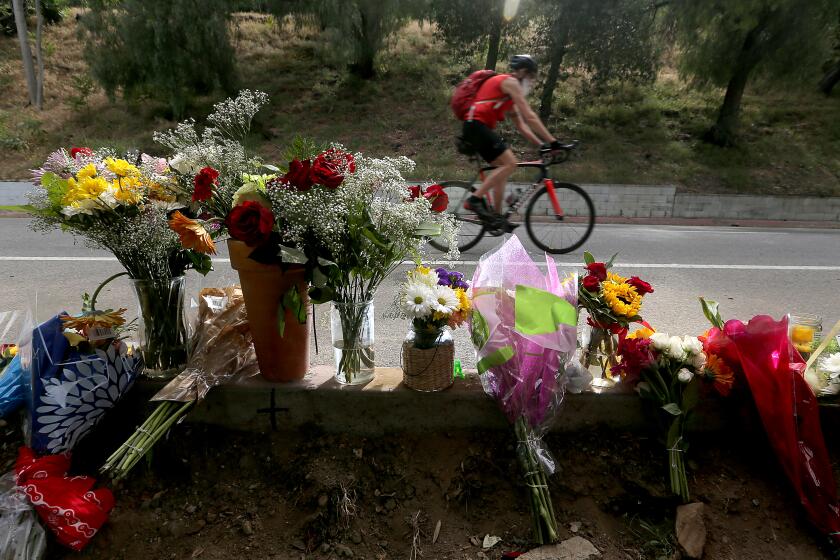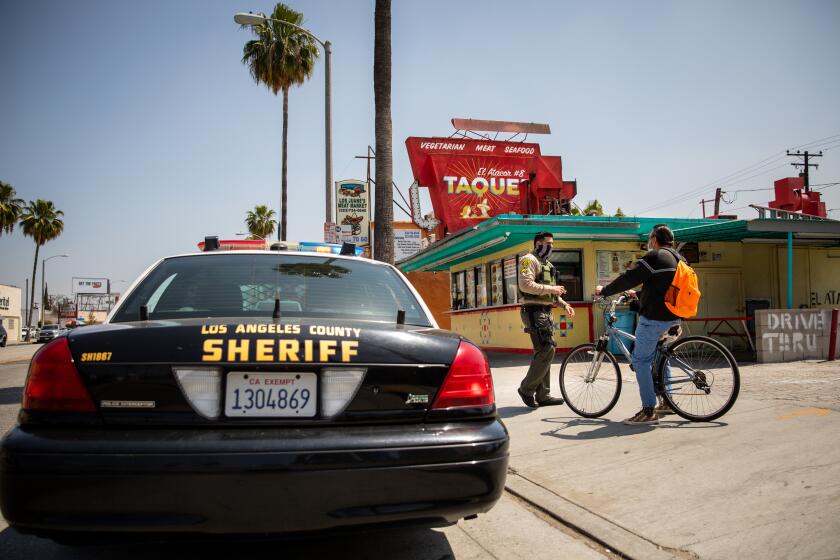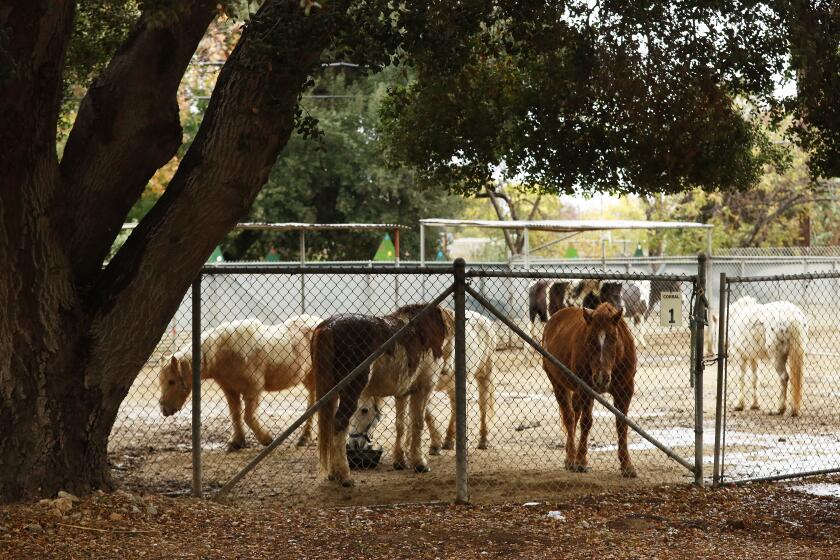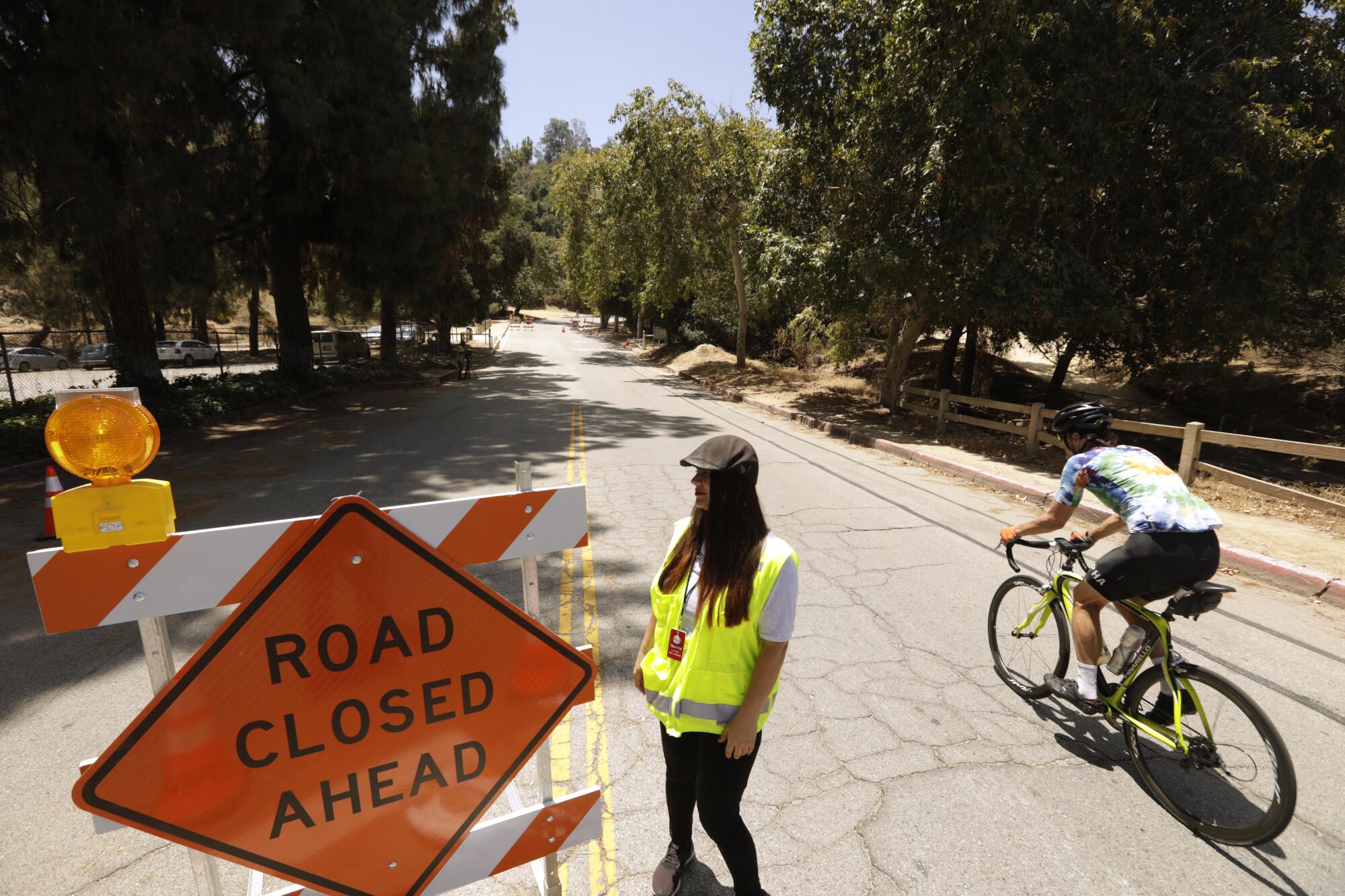
- Share via
When Drew Valenti shares the road with cars from the saddle of his bike in Los Angeles, the thought of getting killed always crosses his mind.
Even in a place like Griffith Park, with its scenic routes that twist through a chaparral expanse of sycamores and live oaks.
“You’re definitely aware of your mortality, pretty much all the time,” Valenti said after a trip through the park, where he rides five times a week since picking up cycling during the pandemic.
Now, city officials have temporarily closed a stretch of Griffith Park Drive, which cuts through the heart of the park — eliminating car traffic in an effort to improve safety for cyclists, runners, hikers and equestrians. The movement caught momentum after the death of experienced cyclist Andrew Jelmert, who was struck from behind by a car during a training ride through the park in April.
“It felt safer,” Valenti said of his most recent ride. “And the result of it feeling safer, it was a more productive ride. You’re able to sort of be in a more meditative state. And I think that’s a good thing for a public park to be able to do for us.”
The pilot program marks a major effort by Los Angeles — a place known as the capital of car culture — to reclaim some public roadways for bikes and pedestrians. The experiment comes amid a time of growing traffic deaths caused by cars on city streets.
With the park’s car-free road, L.A. joins other major cities — including San Francisco, Santa Barbara and New York City — that have closed off stretches to motor vehicles. Many of the changes were intended to address an influx of residents seeking outdoor recreation and commerce amid pandemic lockdowns and social-distancing regulations.
If you’ve been thinking about going car-free in L.A. or even just driving less, these riders’ stories can help you get started.
In April, San Francisco closed most of John F. Kennedy Drive in Golden Gate Park, enshrining what was originally a temporary pandemic measure. Officials seem poised to do the same with a two-mile stretch of the Great Highway, which is open to traffic on weekdays but car-free on weekends.
Santa Barbara closed eight blocks of its downtown to accommodate outdoor dining, and the area is now a respite for runners and cyclists.
And even before the pandemic, officials in New York City made a major chunk of Central Park car-free in 2018.
“What these things do is they make these recreational spaces feel a lot more welcoming for folks on foot, folks on bikes and so forth,” said Michael Manville, an urban planning professor at UCLA’s Luskin School of Public Affairs. “And it’s to accentuate the park’s original purpose as a respite away from the noise and activity of the city.”
Los Angeles in recent years added more than 100 miles of bike lanes, in some cases taking portions of streets away from cars to offer a safer ride for cyclists.
But actually closing roads to eliminate cars is rare.
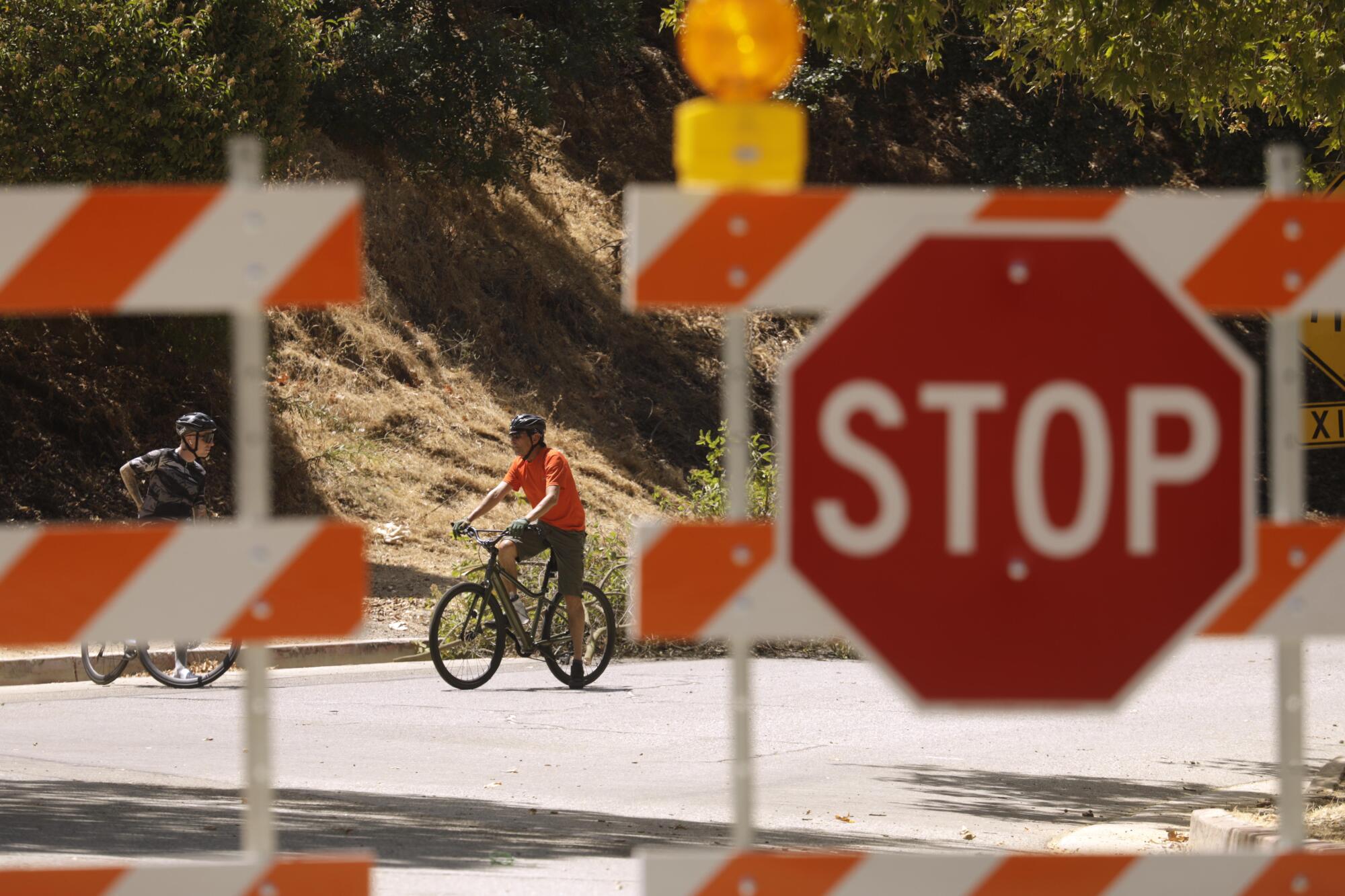
CicLAvia has been shutting down five- to six-mile stretches of L.A. city streets since 2010, to be used only by cyclists and pedestrians, but the closures last for just a few hours every few months.
The last time a street was converted for pedestrian-only use was in 2012, when a short stretch of road in Silver Lake was turned into Sunset Triangle Plaza.
But in May, L.A. City Council and city transportation officials began studying the possibility of making some streets in downtown Los Angeles car-free.
Although Griffith Park is among the largest urban parks in the U.S., roughly 8,500 cars travel on its roads each day, according to the city’s Department of Recreation and Parks.
Pandemic or not, Griffith Park takes you to L.A.’s urban edge and plunges you into what remains of our wilder side. Let this mini-guide send you on your way.
Many drivers use the park’s main roads — Griffith Park Drive and Crystal Springs Drive — as shortcuts to avoid traffic on the 5 and 134 freeways.
Griffith Park’s new car-free space stretches for about two-thirds of a mile on Griffith Park Drive. The primary goal is to eliminate drivers cutting through the park, said L.A. City Councilmember Nithya Raman, whose office commissioned a study of the park’s transportation infrastructure.
The closure is among a series of recommendations from the study.
In addition to eliminating cut-through traffic, the study addresses recommendations to lower driving speeds and to improve bike and pedestrian infrastructure with upgrades such as protected bike lanes and raised crosswalks. Many of Griffith Park’s roads lack bike lanes, and some of those that do exist are obstructed by parked cars or have faded over time, consultants noted in a presentation of the study’s early findings.
Raman, whose district includes Griffith Park, said her office also is considering closing the upper part of Crystal Springs Drive, which spits out onto the 5 Freeway or into Los Feliz.
Prior to its closure last week, 2,000 drivers used Griffith Park Drive on any given day, the city said. Crystal Springs Drive, which runs parallel with the 5 Freeway, still sees about 6,500 cars daily.
Drivers typically enter from the northern part of the park as they exit the 134 Freeway or drive along Zoo Drive.
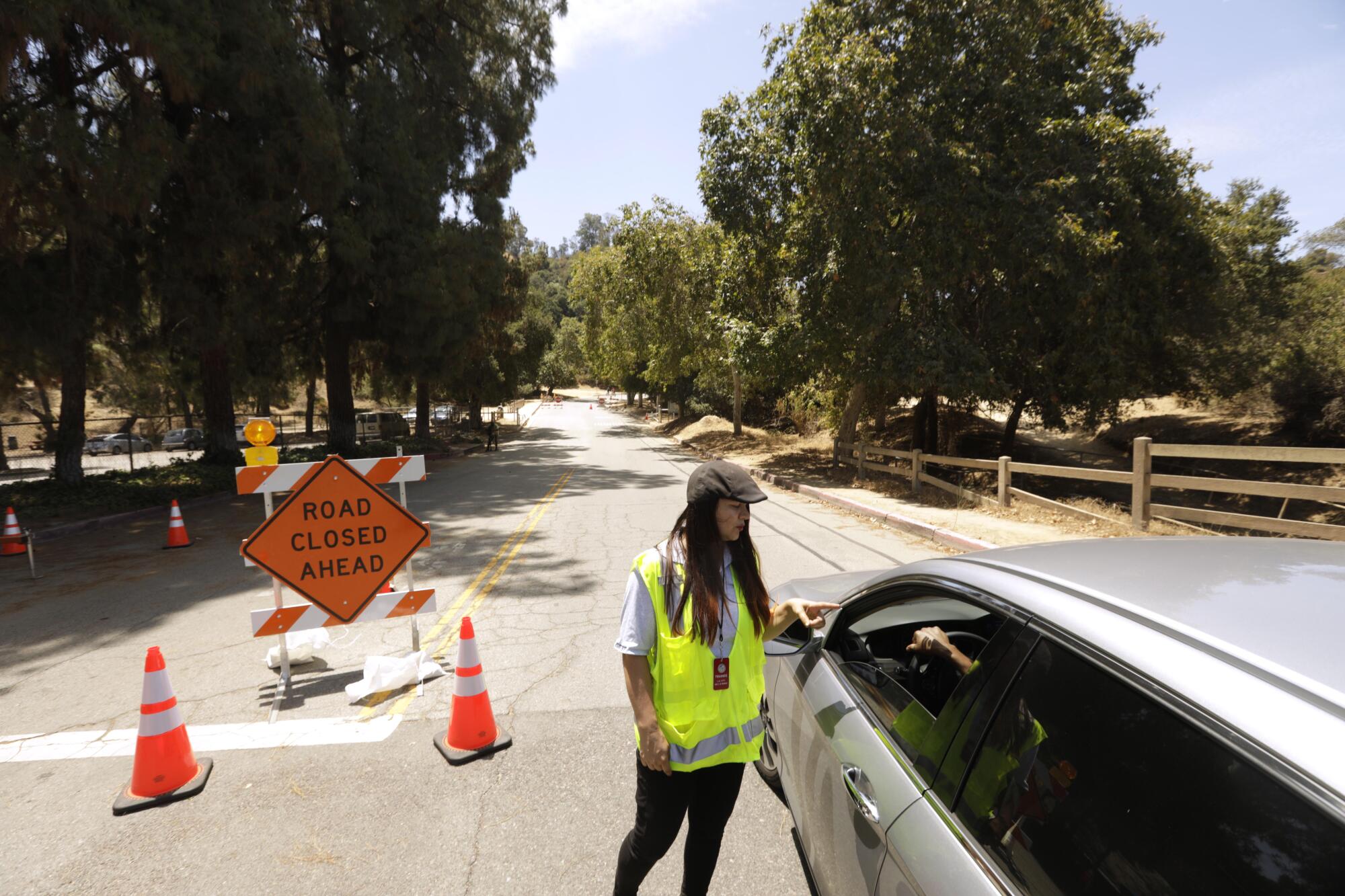
Depending on feedback from the community and its consultants, Raman’s office may make the Griffith Park Drive closure permanent after the pilot program ends July 18.
Other upgrades will depend on things like the city’s budget cycle and buy-in from stakeholders such as the nearby L.A. Zoo and the Autry Museum of the American West, as well as staffing at the Department of Transportation, which Raman wants to expand to accommodate more transportation projects.
Art museums, botanical gardens, cultural marketplaces. Some of the best experiences in the state don’t cost a thing (aside from gas money).
Raman said the campaign to end cut-through traffic in Griffith Park predates her time in office and is nearly a decade old.
Supporters include mobility advocates such as Streets Are For Everyone, known as SAFE, which was founded by Damian Kevitt after he was struck by a car while riding his bike with his wife in Griffith Park in 2013.
“So you do have to evaluate, you know, is it better to cater to people so that they can get home one minute faster? This is not a highway. This is a park.”
— Damian Kevitt, Streets Are For Everyone founder
Kevitt was pinned beneath the car and dragged for a quarter-mile, ripping off part of his right leg. He underwent 11 surgeries over four months in the hospital.
Advocates started a campaign to ban cut-through traffic in the park — including the closure of Griffith Park Drive — about six years ago, Kevitt said. When Jelmert was killed in April, Kevitt said it felt like things had gone full circle.
Citywide, the number of people injured or killed by drivers has risen in the last several years. During the first six months of 2022, severe and fatal collisions increased 12.4% over the same span last year, the Department of Transportation said. So far, 76 pedestrians and seven cyclists have been killed in crashes, and 240 pedestrians and 60 cyclists have been hospitalized with severe injuries.
“This is not a new campaign. What’s new is we have the unfortunate fatality of Andrew Jelmert and a lot of individuals who started standing up and that we galvanized and organized around, [saying], ‘Hey, this park is actually dangerous; it’s actually scary to ride your bicycle in the park,’” Kevitt said. “And the number of people who were like, yeah, I was hit in Griffith Park, you know, it’s a commonplace thing.”
Andrew Jelmert, 77, a Realtor, died at the scene, leaving fellow cyclists shaken and renewing calls for bike lanes in the park.
About a month after Jelmert’s death, SAFE conducted a speed study along the stretch of Crystal Springs Drive where he was struck and found that cars were traveling an average of 36 mph, slightly faster than the rush-hour speed on the 5 Freeway. Some cars moving through the park were clocked at more than 60 mph.
“So you do have to evaluate, you know: Is it better to cater to people so that they can get home one minute faster? Or better to make sure a park is safer so that a person doesn’t die?” Kevitt said. “This is not a highway. This is a park.”
Kevitt said improvements in Griffith Park are part of a larger national discussion of rethinking transportation in the face of major crises, such as housing and climate change.
What L.A. has in common with other cities with similar car-free projects is that each is densely populated, said UCLA’s Manville. Population density makes cities ripe for transportation upgrades beyond car travel.
But what sets L.A. apart, he said, is how committed it remains to the car.
It’s high time that Los Angeles prioritizes Griffith Park users over commuters.
San Francisco and New York are among the few U.S. cities that restrict new parking. In L.A., the opposite is true: Developers of new apartments are often required to build new parking spaces and tend to widen streets to try to accommodate added traffic, Manville said. Improvements to bike and pedestrian infrastructure often take a back seat.
“It is good to make it easier for people to recreationally cycle and walk and feel safe in our own parks,” Manville said. “But the fact is that people also should be able to bike and walk safely just throughout the city. The city should be much more willing to consider things like [car-free stretches] on its actual streets.”
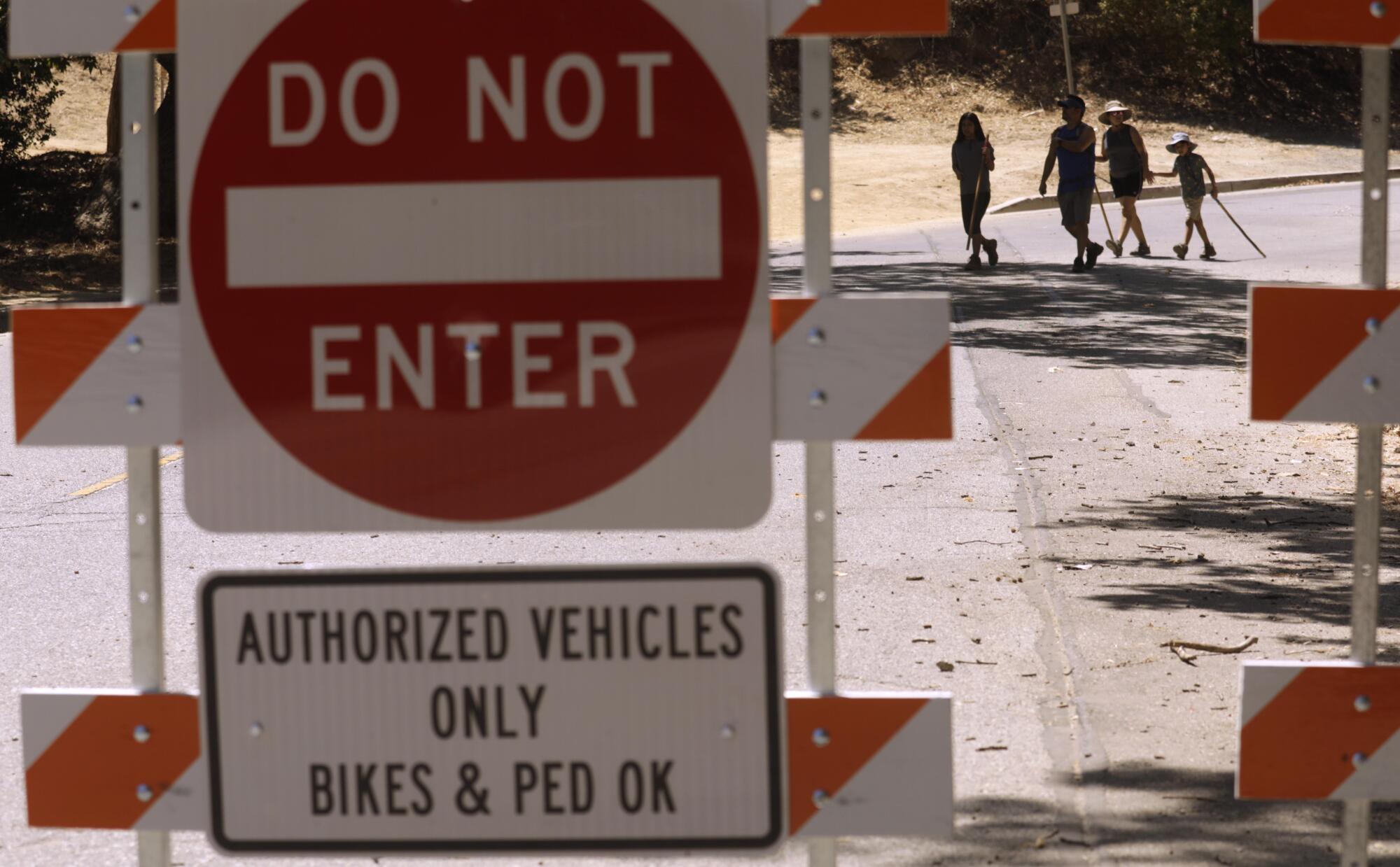
Manville says the pilot program at Griffith Park is another step in the right direction.
The City Council recently passed an ordinance that would require L.A. to stick to its 2035 Mobility Plan, the result of a spirited campaign by environmental and transportation activists. The 2028 Olympics have spurred major public transit projects that would have otherwise been delayed for years. And after pushback from environmental justice advocates, transportation officials have also shown a willingness to steer away from freeway widening projects, which disproportionately displace residents in Black and Latino neighborhoods.
For the most part, residents seem to be in favor of fewer cars on the road too. A recent poll found that Los Angeles voters support adding more dedicated bus and bike lanes.
In Griffith Park, improvements for now come in the form of traffic cones and freestanding “Stop” and “Do not enter” signs weighted by sandbags on each end of the Griffith Park Drive closure. Signs leading up to the barrier warn of the closure, and a city worker is posted at each end to field questions and direct traffic to turn around.
Workers said most drivers are understanding, though one said he encountered a man who was enraged he couldn’t cut through the park for his morning commute to a hospital in Burbank.
Jose Suarez, a Glendale resident, was surprised when he encountered the closure.
A landscape and wildlife photographer, Suarez often uses Griffith Park Drive to navigate the park for his work, but also as a shortcut to avoid freeway traffic. Driving his gray Hyundai sedan, he was on his way to photograph a bird for a company’s logo.
“I don’t have a problem with anybody else trying to use the road as well,” Suarez said of sharing with cyclists. “But why would they close the road? That part doesn’t make sense.”
They’ll squeal with delight while sitting with penguins, hanging with hawks or letting butterflies land on their noses (don’t sneeze!).
Suarez, 26, knows the park well. He grew up in nearby Silver Lake and lived there until 2015, when he and his family were priced out of their home. His parents would bring Suarez and his siblings to hike the park’s trails and leap through its playgrounds after school. Birthdays with carne asada picnics were often hosted at the park. “Some of the best memories I have are there,” he said.
He hoped the city would offer a different solution instead of a full road closure, such as painted bike lanes. Next time, he said, he will park down the hill, hop on his bike and pedal up the road for his photography work.
Since the closure, Colton Miller, who commutes through Griffith Park every day for work, said he’s noticed more cyclists.
Miller said although he welcomes the car-free zone on Griffith Park Drive, he looks forward to further improvements that will slow cars on Crystal Springs Drive, a road that causes him more concern.
Cycling safety became top of mind for Miller in early May when his close friend and fellow cyclist John Hermoso was killed in a traffic collision while riding near Santa Clarita.
“You hear about these collisions, and at the time, you kind of think of it as like something external to yourself, and not necessarily involved,” Miller said. “And then it happens to someone who’s close to you and within close proximity to you, and it does make you rethink a lot of just how you interact with the world around you — a reminder that you’re not invincible, you know. These things can happen to pretty much anyone.”
The Griffith Park Pony Rides have been in operation in some form since 1948.
Hermoso used to lead a Wednesday morning ride through Griffith Park toward the Observatory, starting near the pony stables at the south end of the park. Miller now leads the group, which has grown to more than 50 cyclists, with the ride bearing Hermoso’s nickname: “Panda’s Ponies.”
The route includes Griffith Park Drive, and the possibility of a car crash always worried him during group rides. The way the road hugs the park’s hills and brush leaves drivers and cyclists blind to one another as they make a turn.
“That puts us in a pretty precarious spot,” said Miller, who breathed a little easier after the road was closed to cars.
The highlight of their ride, he said, is when the route breaks off into Mt. Hollywood Drive, where the group climbs up the mountain, winding along roads that have long been closed to traffic save for only the occasional city worker or film crew.
It’s here where Valenti — who at times joins the Wednesday morning rides — finds the most joy in the park. But it’s in the moments when he rides alone that he finds the most peace.
“It’s that solitude. It’s just the only place in the city where you genuinely turn off,” Valenti said. “It can just be you, in the hills, period.”
More to Read
Sign up for Essential California
The most important California stories and recommendations in your inbox every morning.
You may occasionally receive promotional content from the Los Angeles Times.
